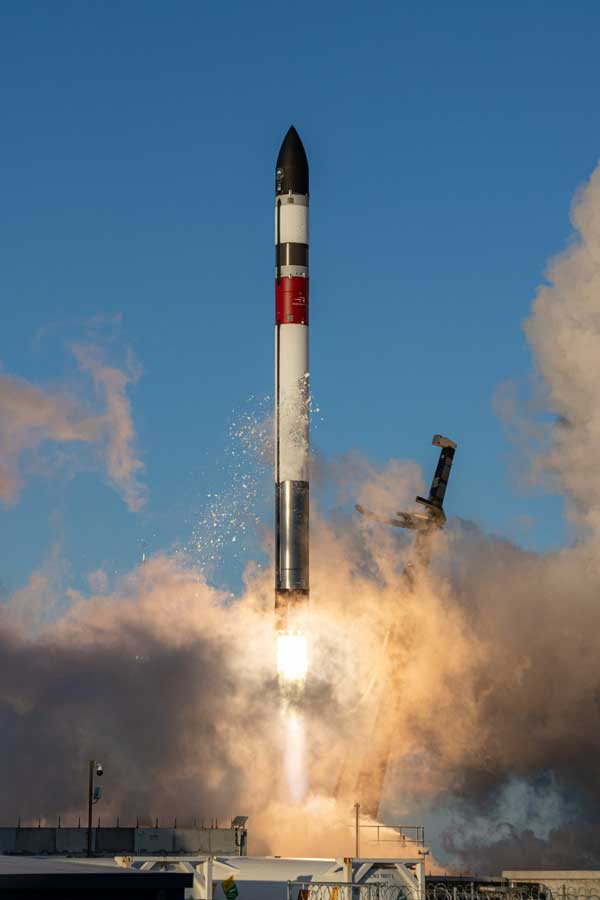
Rocket Lab’s second attempt to recover an Electron rocket first stage in midair with a helicopter failed on Friday when controllers lost telemetry from the booster during reentry and descent, the company said.
Electron’s primary mission, the launch of the Mesospheric Airglow/Aerosol Tomography and Spectroscopy (MATS) satellite for the Swedish National Space Agency, was successful. The satellite utilizes space-borne limb imaging in combination with tomographic and spectroscopic analysis to obtain data on gravity waves.
Rocket Lab said a specially equipped helicopter left the recovery zone after telemetry from the stage was lost. The company said the stage descended under parachute and was recovered from the Pacific Ocean by a ship.
It was Rocket Lab’s second attempt to recover a spent first stage. On May 2, the helicopter briefly captured a stage, but the pilots quickly released it for safety reasons when the booster’s movements didn’t match pre-flight predictions. The stage was recovered from the ocean. Modifications were made to the recovery helicopter’s hardware for the second attempt.
SpaceX is the only launch provider to recover first stages of its rockets. (Virgin Orbit uses a Boeing 747 as the first stage for its LauncherOne booster.) Recovering Electron’s first stage is seen as crucial to lowering Rocket Lab’s launch costs as the company competes with other satellite satellite launch providers and SpaceX’s successful Transporter rideshare missions.
(For more on Transporter missions, see Elon Musk Drinks Your Milkshake: The Impact of SpaceX Rideshare Missions on the Small Satellite Market.)
Rocket Lab has set a new record of nine launches in a calendar year from the Mahia Peninsula in New Zealand. The company is preparing for its first Electron launch next month from Wallops Island in Virginia.
Rocket Lab Opens Test Stand at Stennis
Rocket Lab opened a test stand for hot fires of its Archimedes rocket engines at NASA’s Stennis Space Center in Mississippi. Archimedes engines will power the company’s reusable Neutron launch vehicle.
“It was only a few weeks ago when we announced Stennis as the location of our Archimedes Test Complex and we’re already fast at work to get the site up and running to deliver Neutron,” Rocket Lab Founder and CEO Peter Beck said. “Thanks to our partnership with NASA and the state of Mississippi, we can begin to develop the existing infrastructure and test stand at Stennis to fast-track Neutron’s first launch. We look forward to breathing fire in the great state of Mississippi.”
Rocket Lab is constructing a Neutron production facility on Wallops Island in Virginia on the grounds of the the NASA Wallops Flight Facility and Mid-Atlantic Regional Spaceport. The company expects to conduct operational flights of the booster in 2024.
Rocket Lab Subsidiary Delivers Solar Panels
Rocket Lab also reported that it has delivered the final solar panels to Maxar Technologies that will fly on the Power and Propulsion Element (PPE) of NASA’s crew-tended Gateway lunar space station.
Rocket Lab subsidiary SolAero Technologies manufactured the solar panels, which will supply nearly 70 kilowatts of electrical power to the station. Maxar awarded the contract to SolAero in 2019.
“We are proud to have delivered the final modules to our partners at Maxar for assembly of the Roll Out Solar Array by Deployable Space Systems,” said Brad Clevenger, Rocket Lab’s Vice President & General Manager, Space Systems Power Solutions. “It is an honor for us to be providing such a critical component to Gateway and be part of humanity’s first space station in lunar orbit.”
Astronauts will use the Gateway as a base camp for the exploration of the lunar surface as part of the NASA’s Artemis program.

